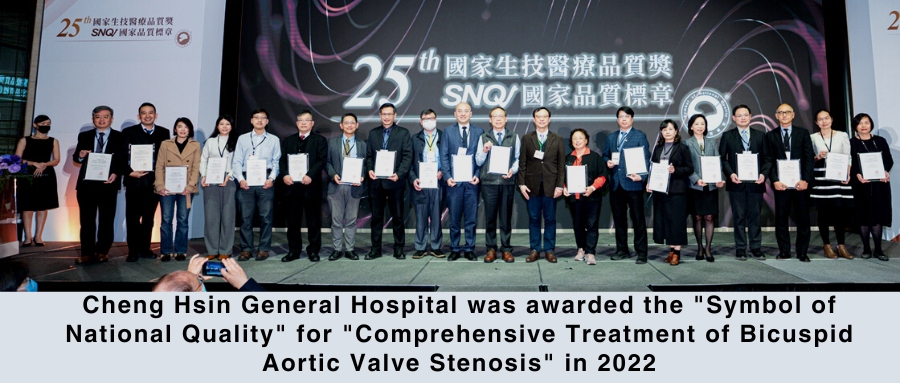Cheng Hsin General Hospital was awarded the “Symbol of National Quality” for “Comprehensive Treatment of Bicuspid Aortic Valve Stenosis” in 2022

Cheng Hsin General Hospital’s Heart Valve team was awarded the “Symbol of National Quality (SNQ)” for their “Comprehensive Treatment of Bicuspid Aortic Valve Stenosis”. In February 2023, Vice Superintendent Yin, Wei-Hsian represented the team at the “PCR Tokyo Valves” in Japan and in April 2023 at the “China Valve” conference held in Hangzhou, China, where he delivered keynote speeches introducing the results of the hospital’s heart valve team in treating bicuspid aortic valve stenosis.

2023-IN-PARTNERSHIP-WITH-CSI-1-1.jpg)

About 15% of middle-aged and elderly patients who receive transcatheter aortic valve replacement (TAVR) have bicuspid aortic valve stenosis. The cause can be attributed to either congenital abnormalities or degenerative changes. The characteristics of bicuspid aortic valve stenosis include asymmetric valve structure, multiple and uneven calcification, and often lead to complications such as rupture of the aortic root structure, coronary artery occlusion, and implanted valve leakage during surgery. Therefore, it was previously excluded as a suitable candidate for TAVR. Although some patients have attempted to undergo transcatheter valve replacement in recent years, it is a highly difficult and complex procedure, challenging for physicians worldwide.
Under the leadership of Superintendent Wei Jeng, the hospital’s heart valve team discovered in 2016 that the success of TAVR for bicuspid aortic valve stenosis depended on the correct selection of the implanted valve size. The valve team further developed the “Wei’s Measurement Method” which precisely selects the valve size preoperatively and optimizes it post-implantation, greatly improving the safety of the surgery, reducing complications, and improving the long-term prognosis. The “Wei’s measurement method” has been validated in over a hundred bicuspid TAVR patients at the hospital, and its results have been published in internationally renowned journals and presented at various international valve conferences in Europe, America, and Asia. Currently, many valve centers in Asia and mainland China routinely use the “Wei’s measurement method” as the standard measurement method for selecting implanted valve size for bicuspid aortic valve stenosis patients, which demonstrates the hospital’s ongoing efforts to innovate and improve in valve treatment.




 Mon~ Fri 8am~5pm.
Mon~ Fri 8am~5pm.




